The Scale and the Spectrum
A history of color-music
James Peel
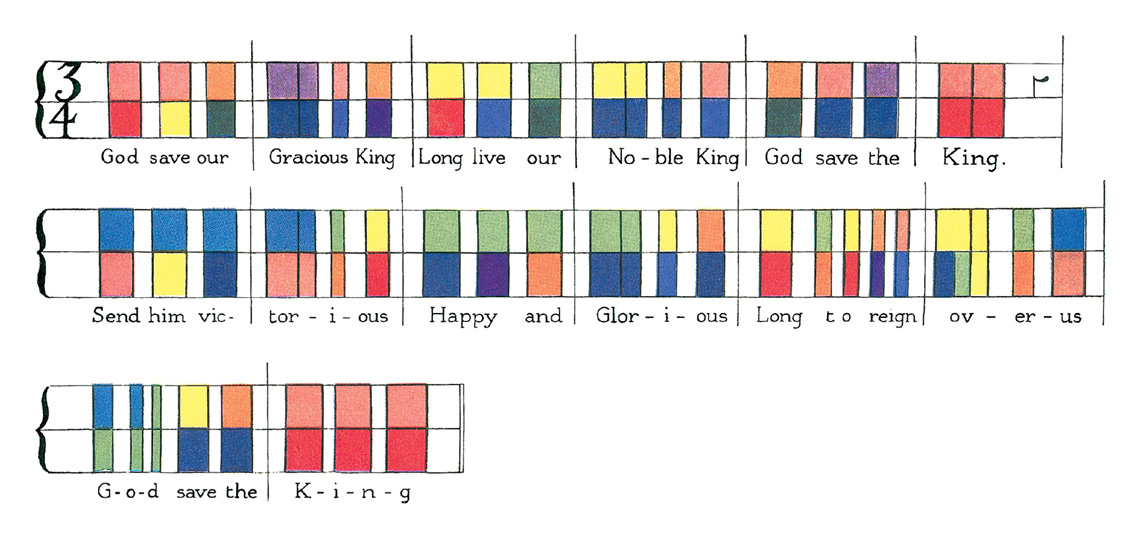
In Close Encounters of the Third Kind (1977), Steven Spielberg uses a hand-sign system for teaching music to deaf children—devised by Zoltán Kodály in the early part of the twentieth century—as an analogy for the way in which man might communicate with a superior alien intelligence. In the visually stunning color-music sequence at the film’s climax, Lacombe (played by the French director François Truffaut) uses a large electric color synthesizer to play Kodály’s code to the visiting spaceship that hovers over him. For Spielberg, we are the deaf children who need to be tutored by a higher power. As one of the actors says when the first contact with aliens occurs: “It’s the first day of school, guys!”
Initially the communication between man and alien is tentative and awkward, and at one point a deep bass note from the alien ship blasts out the window of a control tower. However, in a short while the color-music dialogue has developed into a wonderful symphony of light and sound; the colored patterns flash rhythmically from the spaceship and are answered by a large multi-panelled screen behind the synthesizer.
The Biblical story of the Tower of Babel tells how mankind became separated through language as punishment for our arrogant attempt to reach the heavens, but, as the critic Charlene Engel argues in her essay “Language and the Music of the Spheres in Steven Spielberg’s Close Encounters of the Third Kind,” this passage of Genesis is undone in the final sequence of Spielberg’s film: “Humankind proves it has come of age,” she writes, “by re-achieving its lost unity of language.” Color-music represents a universal language, or Ur-sprache, which is understood throughout the Universe. Pythagoras once supposed a “music of the spheres,” a perfectly harmonious music created by the movement of celestial bodies, which was inaudible on earth. In Close Encounters, this cosmic music is made tangible through the addition of light to tone, thereby allowing for a transcendental moment of communication between man and creatures from outer space.
The idea that color might appeal directly to the emotions at a prelinguistic, but nevertheless comprehensible, level grew out of Pythagoras’s idea of the “music of the spheres.” The earliest instrument to attempt a creative synthesis of color and music was created in the early eighteenth century by the French Jesuit scientist, Louis-Bertrand Castel. In 1725, Castel conceived of a clavecin oculaire, or ocular harpsichord, which he hoped would illuminate the hidden harmonic order thought to exist in the universe. Castel thought of color-music as akin to the lost language of paradise, where all men spoke alike, and he claimed that thanks to his instrument’s capacity to paint sounds, even a deaf listener could enjoy music.
The German polymath Athanasius Kircher had already written about the possibility of visualizing a musical language, based on an analogy between tone and color, in his Musurgia Universalis (1650). “If, when a musical instrument sounds,” Kircher wrote, “someone would perceive the finest movements of the air, he certainly would see nothing but a painting with an extraordinary variety of colors.” Castel took his idea for the ocular harpsichord from Kircher: “Why not make ocular as well as auricular harpsichords?” he wrote in 1725, “It is again to our good friend [Kircher] that I owe the birth of such a delightful idea. Two years ago I was reading his Musurgia: there I found that if during a beautiful concert we could see the air which is agitated by all the various tremors of the voice and instruments we would be astonished to see it sown with the most vivid colors.”
Voltaire, a friend of Castel’s, claimed that Kircher was also the source for Sir Isaac Newton’s analogy between the seven bands of color in the spectrum and the musical scale; Newton had supposed that “colour may be distinguished into its principal degrees, red, orange, yellow, green, blue, indigo and deep violet on the same ground that sound with an eighth is graduated into tones.” Castel took Newton’s spectrum as the basis for his color keyboard, but he developed twelve mid-tones for corresponding semi-tones: B was blue; C sharp, celadon (blue-green); D, green, and so on. The color-octave repeated a tone lighter an octave up and a tone darker an octave down. The correspondence between music and color had another interesting and even earlier precedent, which may also have inspired Castel. In the eleventh century, red or yellow lines placed above musical notation indicated the aural pitches of F sharp and C for singers.
Regretfully, no illustrations or diagrams of Castel’s ocular harpsichords remain. This may be because as a scientific instrument the ocular harpsichord failed—due, in part, to the limitations of eighteenth-century engineering, but also, perhaps, because Castel preferred rhetoric to empiricism; for him, it was the idea of the ocular harpsichord that mattered, not its actual manifestation. In 1726, writing in the Mercure de France, Castel argued that as a mathematician and a scientist he had no desire to turn himself into a “bricklayer in order to create examples of architecture.” The pressure to make the instrument finally came from Voltaire, who, in spite of his sympathy for Castel’s ideas, took his friend to task in his open “Letter to Rameau” of 1727, in which he publicly criticized Castel over his preference for analogy in contrast to Newton’s experimental method.
In 1730, Castel exhibited some kind of device that simply raised colored pieces of paper into view when the corresponding keys were struck. A few years later, he displayed a more sophisticated model, which unfolded chromatically graded ribbons when it was played. Although this instrument was apparently a sensation when first shown in Paris, Castel closed his doors to the public soon afterward; he felt the ocular harpsichord was not yet ready for a performance. Alban Butler, an Englishman who visited Castel’s Parisian workshop in 1734, saw the renowned instrument and stated that Castel’s project was still far from his goal. “This instrument is not finished,” he wrote, “and gives only three colors.”
Castel’s most ambitious ocular harpsichord was made by an English assistant (whose name is not recorded) and exhibited in London in 1757, the year of Castel’s death. The instrument was reportedly a remarkable object to behold. Its scale alone suggests physical grandeur—at twelve octaves, it was nearly twice the size of a grand piano, with each of the 144 keys operating individual shutters over identical square apertures containing color-coded panels of tissue paper. The instrument worked with a complex system of pulleys, levers, and shutters and, as each color on Castel’s machine demanded an individual candle, this “behemoth,” as a contemporary pamphlet described it, must have dazzled when lit. Unfortunately, its performance at the concert rooms of Soho Square, London, was cancelled because the instrument was deemed too great a fire risk.
• • •
In the late nineteenth century, there was a resurgence of interest in color-music organs, which appealed to the Romantic aestheticians’ search for the universal principles of color harmony. Color, it was hoped, would strike the sensitive viewer at an emotional rather than intellectual level. As no illustrations remained of Castel’s instruments, these later exponents of color-music, such as Bainbridge Bishop and Alexander Rimington, could be forgiven for thinking that they had discovered a new art form.
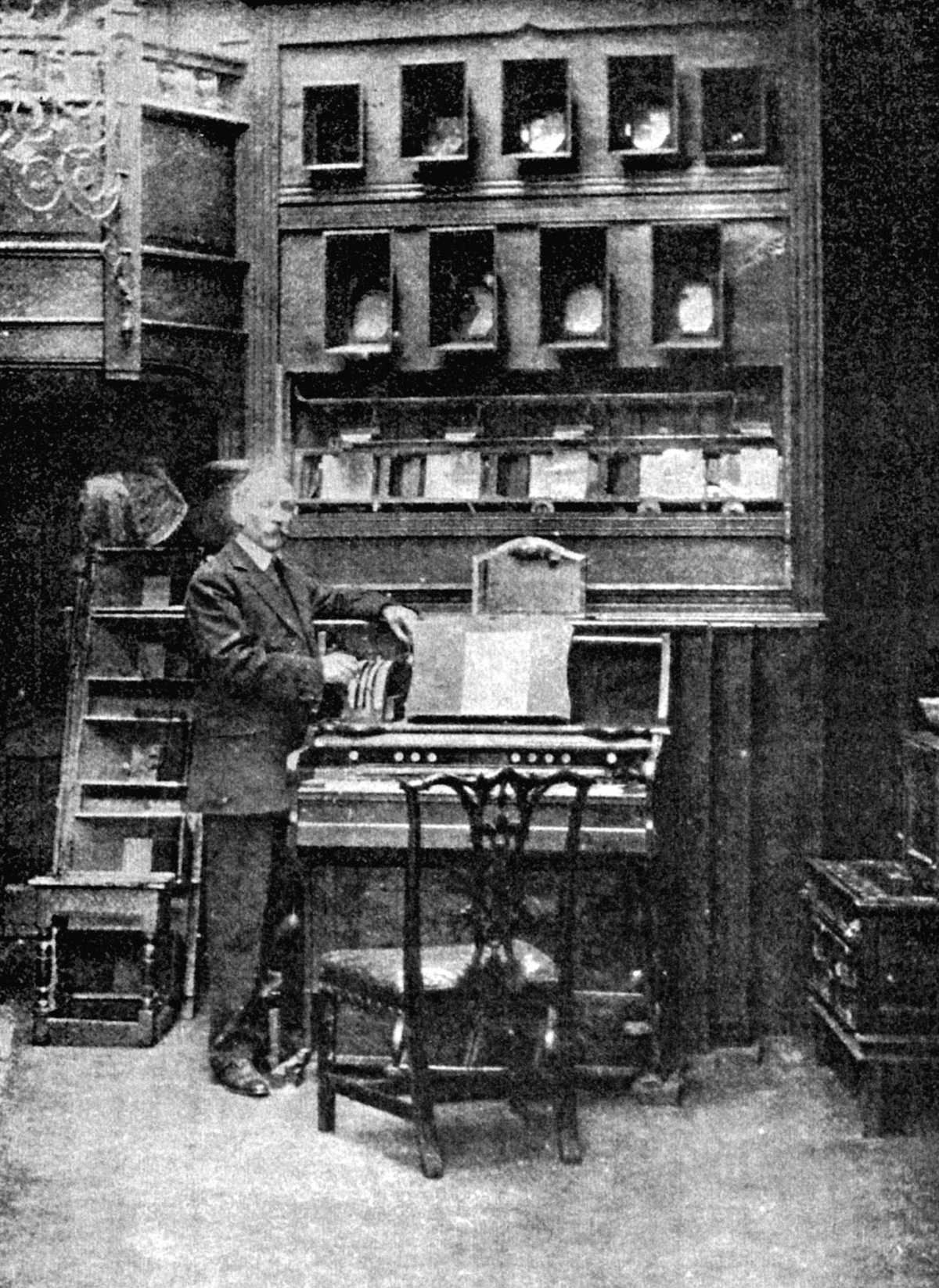
In contrast to Castel’s interest in the possibility of a language of color, drawn from an analogy between light and tone, Bishop and Rimington were inspired by French Impressionist techniques. Their instruments overlaid the projected individual colors into specially set-up spaces, merging the colors across large screens in an abstract, painterly fashion. In his essay, “A New Art: ‘Colour-Music’” (1895), Rimington compared the color organ’s keyboard to a large palette “from which we can paint with instantaneous effect upon the screen the colours being at will combined into one chord, or compound tint upon its surface.” He claimed his “new art” would mobilize color to create a new visual experience that would free art from the two-dimensional restrictions of the canvas.
Rimington patented his Colour Organ in 1895, the same year that cinema was invented, and like moving pictures, Rimington’s design exploited the advantages of electricity to create powerful projections—he boasted that his Colour Organ consumed the equivalent power of 1,300 candles. The instrument operated by passing light through carefully tinted glass discs, which rotated in order to vary the intensity of the different hues. It was three meters high and resembled a house organ with a cabinet of fourteen colored lamps on top. However, as with Castel’s clavecin oculaire, it did not produce musical sounds. Rimington’s color keyboard code, like Bishop’s, took C as red and progressed through the spectrum, but the light of the colored lamps could be adjusted to certain gradations of hue, brightness, and saturation, making it far more sophisticated than Castel’s ocular harpsichord.
Rimington’s instructions to the operator of his device suggest that a Wagnerian trumpet blast should be signaled by an intense orange, “which palpitates with the harmonic colours corresponding to a subordinate passage on some of the other orchestral instruments. The blast ceases; there is a faint echo of it upon the violins, while the screen pulsates with pale lemon and saffron hardly discernable. Again comes the blast of trumpets, and once more the screen flames with orange modulations.”
This hope that the Colour Organ might approximate the Wagnerian idea of the Gesamtkunstwerk was taken to its furthest extreme by the Russian composer Alexander Scriabin in his hybrid symphony Prometheus: The Poem of Fire. Scriabin was a theosophist who had discovered his synaesthetic ability at a concert in the company of Rimsky-Korsakov when they both agreed that the piece in D major appeared yellow. His color keyboard code disregarded the Newtonian spectrum and was based on his own subjective impressions; for instance, he saw E flat as metallic grey/blue.
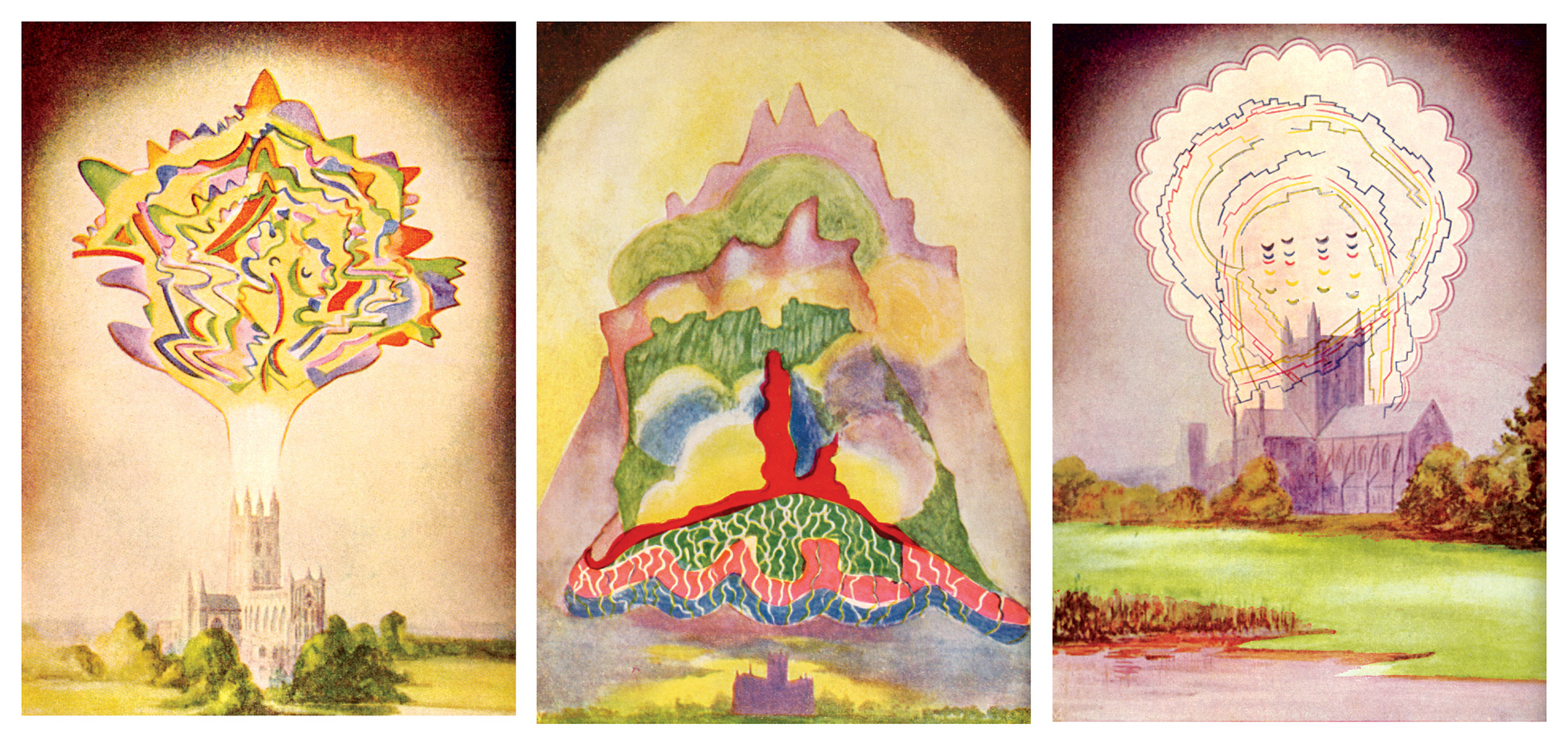
For Prometheus, which premiered in New York in 1915, Scriabin wrote a “Luce” (light score) above the instrumental score. The instrument—called the Chromola—that was used to project the “Luce” was based on Rimington’s Colour Organ. The colors appeared on a huge box suspended above the orchestra, which contained eight by ten-foot mesh screens of different degrees of transparency. Scriabin requested that the audience all wear white clothes, so that the reflected light incorporated them into his dynamic multimedia spectacle. The reviews that followed the New York performance were mixed and inconclusive. Viewers found it difficult to relate the timing and intensity of the colors to the music and one critic dismissed it as “a pretty poppy show.”
• • •
The color-music paintings I have made follow Castel (and Kodály) in attempting to make “music for deaf people”: abstract works that present a visual installation of silent music. I took Castel’s color-keyboard code as the basis for visualizing pitch and devised a second code, which makes visible the tempo of the score. This code takes a crotchet as a certain width, with longer and shorter notes having correspondingly longer or shorter shapes. Each bar is divided horizontally into six lines and there is space for up to three notes in the treble and three notes in the bass clef to be played at any one time.
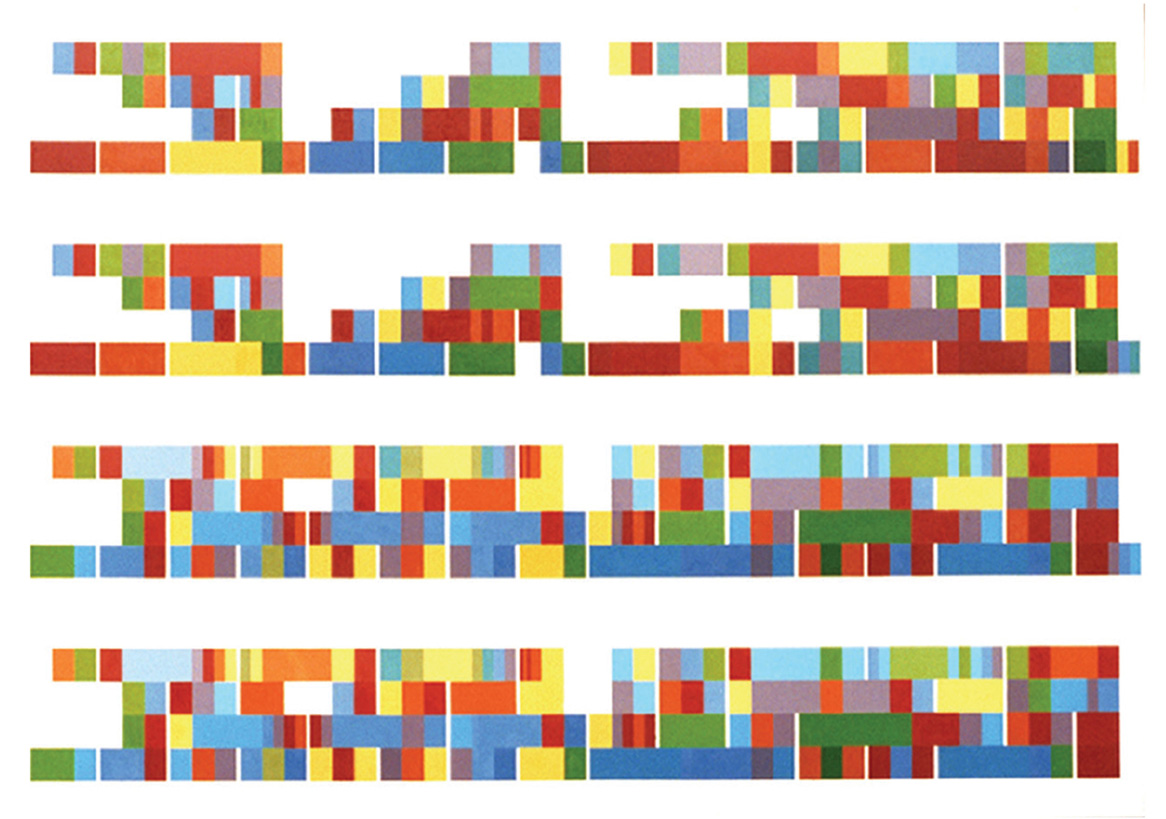
Each painting starts at the top left of the canvas and works eight bars across, four times, to complete a total of 32 bars. The paintings represent scores from Bach’s Goldberg Variations. I chose the Variations because they were written in the early eighteenth century, and so it is possible that they were played on Castel’s ocular harpsichord. Their rich mathematical and harmonic structures would have particularly suited the challenges of such an instrument.
Bach’s music can also be linked to the synthesized color sequence in Close Encounters. In 1967, the composer and recording artist Wendy Carlos recorded Switched on Bach on a Moog synthesizer; the record sleeve shows an actor posing as Bach in eighteenth-century garb and a powdered wig in front of the space-age looking instrument. This famous recording apparently inspired Alan R. Pearlman, who went on to found ARP instruments, one of the seminal synthesizer companies of the 1970s. Pearlman came from a background in classical music and had spent five years working as an engineer designing amplifiers for the Apollo and Gemini space programs for NASA. It is the ARP 2500 that went on to create synthesizer lore by being used in Spielberg’s Close Encounters. In the film, the original aspirations of Castel’s ocular harpsichord appear to be finally realized. However, when I recently spoke to Philip Dodds, the former ARP engineer who appears in Close Encounters as the synthesizer operator, he told me that the synthesizer and light console used in the film were never actually linked.
Inevitably the question remains—are all ocular harpsichords ultimately doomed to failure? Is it possible to create a color-music instrument that will provide a collective sensory experience comparable to what someone with synaesthetic capabilities experiences? Probably not; color-music fascinates because it inhabits the liminal state between two senses, a metaphor for the invisible threads that connect our perception of the world. There is no universal language of color that can be understood on a subliminal level, only a wide range of symbolic associations. Perhaps what the analogy of music and color can allow is a method for translating the subtleties of a musical score and, as Castel originally intended, color-music might be better left as a “thought experiment.”
However, there is something attractive about the foolhardy quest for a music of color that appeals to me. These intellectual flights of fantasy teeter like ambitious Towers of Babel in the imagination. Before his death, Scriabin was working towards one such megalomaniacal venture, titled Mysterium, which was to be performed in the foothills of the Himalayas. He imagined bells suspended from clouds to summon spectators, sunrises as preludes and sunsets as codas, flames throwing up sheets of fire, and scents choreographed in the air. At the end of the seven-day performance, his antithesis to God’s creation, the world was to explode in an apocalyptic flash of mystical bliss.
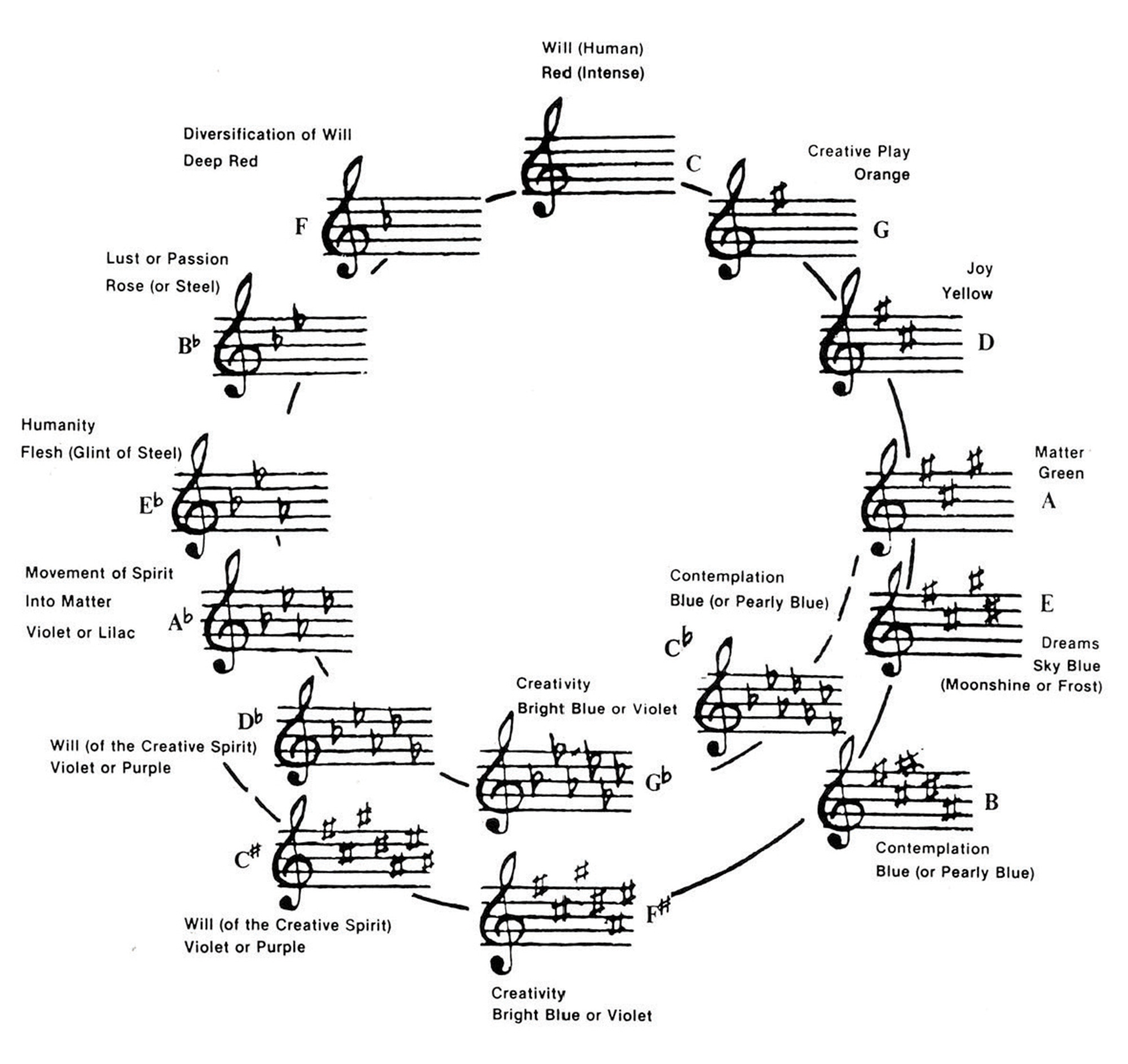
James Peel is a graduate of the Royal College of Art. He is a multimedia conceptual artist who has exhibited at Tate Liverpool and the Henry Moore Institute and is currently a resident of the Emmanuel Hoffman Foundation in Basel, where he is working on a series of projects that explore the nature of rainbows and the music of waterfalls in relation to the forgotten universal language of Solresol, invented by Jean François Sudre in the mid-nineteenth century.
Spotted an error? Email us at corrections at cabinetmagazine dot org.
If you’ve enjoyed the free articles that we offer on our site, please consider subscribing to our nonprofit magazine. You get twelve online issues and unlimited access to all our archives.